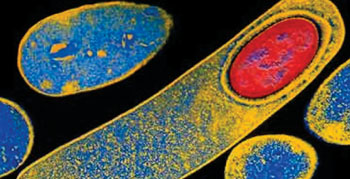New Infectious Disease Test Promises Quick Diagnosis
|
By LabMedica International staff writers Posted on 05 Jan 2016 |

Image: Colored Transmission electron micrograph of Clostridium difficile forming an endospore (red) (Photo courtesy of Dr. J. Thomas Lamont).
Early detection of specific pathogens has long been recognized as a vital strategy in the control of infectious diseases because it can lead to timely care of patients and prevent potential outbreaks.
The detection of specific bacteria represents a significant challenge because of the presence of many different species of bacteria in biological samples. Furthermore, for any given species of bacterium, only virulent strains are infectious while other strains of the same species may be harmless or even beneficial to human health.
A team of scientists led by those at McMaster University (Hamilton, ON, Canada) found a way to make DNAzymes, or single-stranded catalytic DNA molecules from a simple test tube technique that allows for isolation of rare DNA sequences with special functions. The team's first success was the development of a molecular probe that precisely recognizes the strain which caused the outbreak of Clostridium difficile infection in Hamilton, Ontario in 2011. This strain was very infectious, resistant to antibiotics and even fatal to some patients. Instead of having to do several different tests to narrow down to a positive identification of the specific strain, the scientists can now quickly pinpoint this superbug using their new molecular probe.
The team obtained an RNA-cleaving fluorogenic DNAzyme (RFD) that can recognize an infectious strain of C. difficile. This DNAzyme not only exhibits no cross-reactivity to other bacterial species, but also is highly strain-selective for C. difficile. The special DNAzyme (catalytic DNA), RFD-CD1, showed exquisite specificity for a pathogenic strain of C. difficile. RFD-CD1 was derived by an in vitro selection approach where a random-sequence DNA library was allowed to react with an unpurified molecular mixture derived from this strain of C. difficile, coupled with a subtractive selection strategy to eliminate cross-reactivities to unintended C. difficile strains and other bacteria species.
Bruno J. Salena, MD, an associate professor of medicine and coauthor of the study, said, “This technology can be extended to the further discovery of other superbug strain-specific pathogens. For example, such technology would prove useful in the identification of hypervirulent or resistant strains, implementation of the most appropriate strain-specific treatments and tracking of outbreaks.” The study was published on December 16, 2015, in the journal Angewandte Chemie International Edition.
Related Links:
McMaster University
The detection of specific bacteria represents a significant challenge because of the presence of many different species of bacteria in biological samples. Furthermore, for any given species of bacterium, only virulent strains are infectious while other strains of the same species may be harmless or even beneficial to human health.
A team of scientists led by those at McMaster University (Hamilton, ON, Canada) found a way to make DNAzymes, or single-stranded catalytic DNA molecules from a simple test tube technique that allows for isolation of rare DNA sequences with special functions. The team's first success was the development of a molecular probe that precisely recognizes the strain which caused the outbreak of Clostridium difficile infection in Hamilton, Ontario in 2011. This strain was very infectious, resistant to antibiotics and even fatal to some patients. Instead of having to do several different tests to narrow down to a positive identification of the specific strain, the scientists can now quickly pinpoint this superbug using their new molecular probe.
The team obtained an RNA-cleaving fluorogenic DNAzyme (RFD) that can recognize an infectious strain of C. difficile. This DNAzyme not only exhibits no cross-reactivity to other bacterial species, but also is highly strain-selective for C. difficile. The special DNAzyme (catalytic DNA), RFD-CD1, showed exquisite specificity for a pathogenic strain of C. difficile. RFD-CD1 was derived by an in vitro selection approach where a random-sequence DNA library was allowed to react with an unpurified molecular mixture derived from this strain of C. difficile, coupled with a subtractive selection strategy to eliminate cross-reactivities to unintended C. difficile strains and other bacteria species.
Bruno J. Salena, MD, an associate professor of medicine and coauthor of the study, said, “This technology can be extended to the further discovery of other superbug strain-specific pathogens. For example, such technology would prove useful in the identification of hypervirulent or resistant strains, implementation of the most appropriate strain-specific treatments and tracking of outbreaks.” The study was published on December 16, 2015, in the journal Angewandte Chemie International Edition.
Related Links:
McMaster University
Latest Technology News
- AI Saliva Sensor Enables Early Detection of Head and Neck Cancer
- AI-Powered Biosensor Technology to Enable Breath Test for Lung Cancer Detection
- AI Model Achieves Breakthrough Accuracy in Ovarian Cancer Detection
- Portable Biosensor Diagnoses Psychiatric Disorders Using Saliva Samples
- Cell-Sorting Device Uses Electromagnetic Levitation to Precisely Direct Cell Movement

- Embedded GPU Platform Enables Rapid Blood Profiling for POC Diagnostics
- Viral Biosensor Test Simultaneously Detects Hepatitis and HIV
- Acoustofluidic Device to Transform Point-Of-Care sEV-Based Diagnostics
- AI Algorithm Assesses Progressive Decline in Kidney Function
- Taste-Based Influenza Test Could Replace Nasal Swabs with Chewing Gum
- 3D Micro-Printed Sensors to Advance On-Chip Biosensing for Early Disease Detection
Channels
Clinical Chemistry
view channel
Chemical Imaging Probe Could Track and Treat Prostate Cancer
Prostate cancer remains a leading cause of illness and death among men, with many patients eventually developing resistance to standard hormone-blocking therapies. These drugs often lose effectiveness... Read more
Mismatch Between Two Common Kidney Function Tests Indicates Serious Health Problems
Creatinine has long been the standard for measuring kidney filtration, while cystatin C — a protein produced by all human cells — has been recommended as a complementary marker because it is influenced... Read moreMolecular Diagnostics
view channel
Urine Test Detects Inherited Neuropathy Missed by Genetic Screening
Sorbitol dehydrogenase (SORD)-related neuropathy is one of the most common inherited nerve disorders, yet diagnosis often lags because current genetic screens frequently miss the causal gene.... Read more
Genomic Test Predicts Risk of SCC Metastasis
Managing squamous cell carcinoma (SCC) of the skin in patients with one or more risk factors is a significant clinical challenge, especially as SCC-related deaths are now estimated to exceed those from melanoma.... Read moreHematology
view channel
Platelet Activity Blood Test in Middle Age Could Identify Early Alzheimer’s Risk
Early detection of Alzheimer’s disease remains one of the biggest unmet needs in neurology, particularly because the biological changes underlying the disorder begin decades before memory symptoms appear.... Read more
Microvesicles Measurement Could Detect Vascular Injury in Sickle Cell Disease Patients
Assessing disease severity in sickle cell disease (SCD) remains challenging, especially when trying to predict hemolysis, vascular injury, and risk of complications such as vaso-occlusive crises.... Read more
ADLM’s New Coagulation Testing Guidance to Improve Care for Patients on Blood Thinners
Direct oral anticoagulants (DOACs) are one of the most common types of blood thinners. Patients take them to prevent a host of complications that could arise from blood clotting, including stroke, deep... Read moreImmunology
view channel
Chip Captures Cancer Cells from Blood to Help Select Right Breast Cancer Treatment
Ductal carcinoma in situ (DCIS) accounts for about a quarter of all breast cancer cases and generally carries a good prognosis. This non-invasive form of the disease may or may not become life-threatening.... Read more
Blood-Based Liquid Biopsy Model Analyzes Immunotherapy Effectiveness
Immunotherapy has revolutionized cancer care by harnessing the immune system to fight tumors, yet predicting who will benefit remains a major challenge. Many patients undergo costly and taxing treatment... Read morePathology
view channel
Blood Test and Sputum Analysis Predict Acute COPD Exacerbation
Chronic obstructive pulmonary disease (COPD) remains a major contributor to global illness, largely driven by cigarette smoking and marked by irreversible lung damage. Acute exacerbations can accelerate... Read more
AI Tool to Transform Skin Cancer Detection with Near-Perfect Accuracy
Melanoma continues to be one of the most difficult skin cancers to diagnose because it often resembles harmless moles or benign lesions. Traditional AI tools depend heavily on dermoscopic images alone,... Read more
Unique Immune Signatures Distinguish Rare Autoimmune Condition from Multiple Sclerosis
Myelin oligodendrocyte glycoprotein antibody–associated disease (MOGAD) is a rare autoimmune disorder in which the immune system attacks the myelin sheath in the central nervous system. Although symptoms... Read moreTechnology
view channel
AI Saliva Sensor Enables Early Detection of Head and Neck Cancer
Early detection of head and neck cancer remains difficult because the disease produces few or no symptoms in its earliest stages, and lesions often lie deep within the head or neck, where biopsy or endoscopy... Read more
AI-Powered Biosensor Technology to Enable Breath Test for Lung Cancer Detection
Detecting lung cancer early remains one of the biggest challenges in oncology, largely because current tools are invasive, expensive, or unable to identify the disease in its earliest phases.... Read moreIndustry
view channel
Abbott Acquires Cancer-Screening Company Exact Sciences
Abbott (Abbott Park, IL, USA) has entered into a definitive agreement to acquire Exact Sciences (Madison, WI, USA), enabling it to enter and lead in fast-growing cancer diagnostics segments.... Read more
























